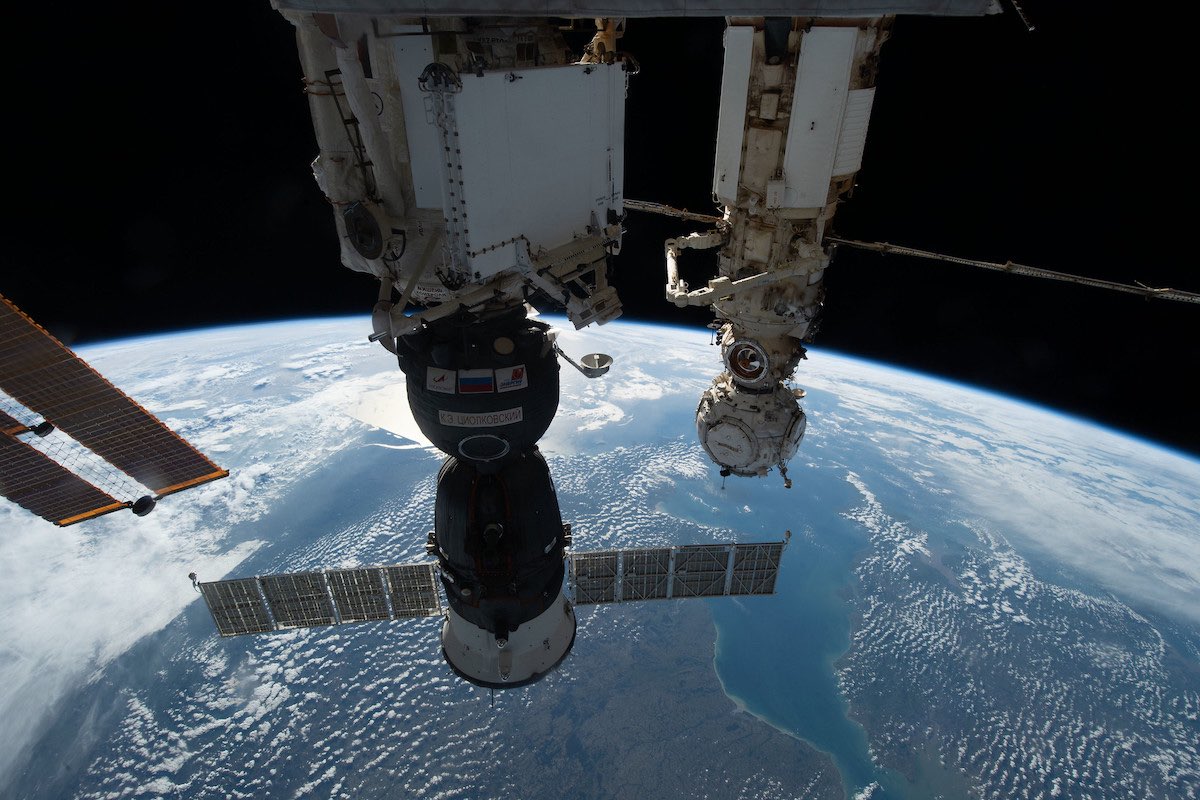
Russian managers are assessing whether a damaged Soyuz spacecraft docked at the International Space Station can safely carry its three-man crew back to Earth in late March as planned or whether a replacement must be launched to take its place, officials said Monday.
“I believe that at the end of December, specialists … will decide on how we will resolve this situation,” Yuri Borisov, director of the Russian space agency Roscosmos, said in an interview with the daily Izvestia.
The Soyuz MS-22/68S crew ferry ship presumably was hit last Wednesday by a small piece of space debris or a micrometeoroid that ruptured a coolant line, resulting in an hours-long spray of icy particles that spewed away into space. Cameras on the station have since located a small puncture indicating an impact.
With most, if not all, its coolant gone, temperatures in the dormant spacecraft have stabilized at around 86 degrees. The Russians say that’s within “acceptable limits,” but it’s not clear how that might change when the ship is powered up for re-entry and landing.
If the engineers conclude the vehicle is still flight worthy, cosmonauts Sergey Prokopyev and Dmitri Petelin, along with NASA astronaut Frank Rubio, could use it as planned to return to Earth in late March to wrap up a 187-day stay in space.
If the investigators determine the lack of coolant precludes a safe re-entry, a Soyuz already being prepared for the next crew rotation mission could be launched ahead of schedule with no one on board. That Soyuz, like all Russian crew ships, is designed for autonomous dockings with the space station.
Under that scenario, the damaged Soyuz MS-22/68S vehicle could be jettisoned ahead of time and Prokopyev, Petelin and Rubio could come home in the replacement ship. Whether they would come home early, on time or after an extended stay is not yet known.
In the meantime, “there is no hurry,” Borisov told Izvestia.
“If the situation is under control and we are fully confident in the spaceship’s working capacity, it will be used for the crew’s standard descent as was planned in March,” he said. “If the situation develops under a different scenario, we, of course, have backup options.”
He was referring to the Soyuz MS-23/69S spacecraft already at the Baikonur Cosmodrome in Kazakhstan undergoing normal pre-flight testing for launch on March 16, carrying cosmonauts Oleg Kononenko, Nikolai Chub and NASA astronaut Loral O’Hara to the space station. They will replace Prokopyev, Petelin and Rubio in a normal crew rotation sequence.
A Russian Soyuz crew ferry ship docked to the International Space Station is spewing particles of an unknown substance, presumably coolant fluid, into space, forcing two cosmonauts to call off a planned spacewalk tonight. Watch live: https://t.co/2lnIsF9yec pic.twitter.com/PeVYnYldon
— Spaceflight Now (@SpaceflightNow) December 15, 2022
If the damaged MS-22 spacecraft can’t be used to bring Prokopyev and his crewmates home as planned on March 28, the MS-23 spacecraft could be launched without a crew to take its place.
In that case, Kononenko, Chub and O’Hara would have to wait for a downstream flight, but how the always complex crew rotation schedule would play out under that scenario is not yet known.
The coolant leak developed last Wednesday as Prokopyev and Petelin were preparing to float outside the station for an already planned spacewalk. Russian flight controllers noticed a sudden drop in pressure in a Soyuz coolant line. Cameras aboard the lab spotted a thick jet of icy particles streaming away into space, indicating a massive leak of some sort.
The leak lasted for several hours, draining most, if not all, of the coolant in a radiator loop.
Flight controllers studied telemetry and carried out tests of the vehicle’s propulsion system Saturday and found no other problems. The only issue appears to be the loss of coolant.
Overnight Sunday, flight controllers at the Johnson Space Center in Houston used the station’s Canadian-built robot arm to carry out a close-range photo survey. The arm’s camera spotted what sources said appeared to be a small puncture. Borisov was quoted by Izvestia saying the hole was “tiny.”
from Spaceflight Now https://ift.tt/dl89kqO
via World Space Info







0 comments:
Post a Comment